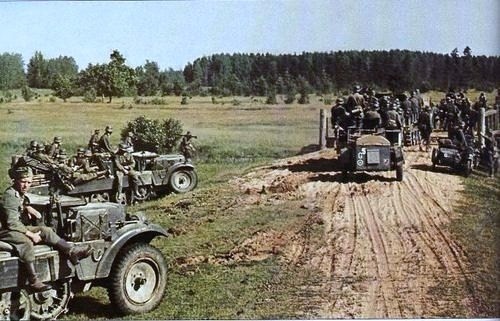A Sunday afternoon on a beach in the heart of Townsville. The unidentified men and women on the beach represent the Australian Military Forces, United States Provost Corps, Australian Army Intelligence and the Royal Australian Navy. Defensive barbed wire entanglements can be seen in the background running across the beach.
Drawing by Roy Hodgkinson, 1942.
Source AWM
Drawing by Roy Hodgkinson, 1942.
Source AWM
Douglas Dillard, a 19 year old sniper of the 551st in France, 1944. Dillard went on to serve in the Korean war and Vietnam war.
Another photo of Dillard, in the Ardennes
Source of second photo and interview of Dillard found here
Summer 1942-in the Kuban-Kalmyk Steppes. Armored soldiers standing on Panzer IV (short) in front of thatched House asking for water-According to full translation this photo was taken near the town of Elista near the Caspian Sea leading one to believe this unit belonged to 16th Motorized Infantry Division who was doing reconnaissance in the vast no-man's land between Astrakhan and the Terek river.
An advance party of the 3rd Panzer-Division south of Brest-Litowsk on June 22nd, 1941. This photo was taken in the early moments of the Battle of Brest.
This video is a modern day dramatization of the defense of the Brest Fortress.
This video is a modern day dramatization of the defense of the Brest Fortress.
An American soldier on the deck of the destroyed French battleship Strasbourg in Toulon, August 1944. Near the battleship, on its side, is the light cruiser La Gallissoniere.
An RAF crewman displaying a pair of pigeons that were carried by Avro Lancanster bombers. The idea was that if the bomber crashed in German-occupied territory, the crew could release the pigeons. The pigeons would fly back to the home base to deliver a message about the crash. Before electricity and telegraph, homing pigeons were used as a sort of a mail service to deliver messages.
Crewmen of Liberator GR Mark VA, BZ818 'C', of No. 53 Squadron handling carriers containing homing pigeons at St. Eval, Cornwall, after a patrol over the Bay of Biscay. Sergeant J Knapp of Toronto, Canada, (in the hatchway) hands a carrier to Sergeant W Tatum of London, while Warrant Officer A Mackinnon of Auckland, New Zealand, holds a second carrier.
People going to market in Lubny Ukraine, 1941. They are seemingly oblivious, except for one child, to the dead man on the street. He had been shot by the Germans. On October 16, 1941 over a thousand of the city's Jews, including women and children, were massacred by German Einsatzgruppen on the outskirts of the city.
These photos purport to be the only color photos of the Germans' World War II surrender.
Source
Although defeated and just days after the Fuhrer's suicide, the never-seen-before photos show the German officers looking immaculate yet menacing in their long overcoats and jackboots.
Until now the only images of the momentous occasion in existence are the official black and white ones held by the Imperial War Museum.
Mr Playforth kept hold of his pictures along with a handwritten speech Montgomery wrote in March 1945 to rouse British soldiers ahead of a final push into Germany.
The historic items have remained in Mr Playforth's family ever since but have now been made public for the first time as they are being sold at auction.
Andrew Aldridge, of Henry Aldridge Auctioneers of Devizes, Wilts, said: 'Playforth knew he was about to witness one of the most important events of the 20th century.
'He was of too low a rank to be present so he crept into the trees and bushes on the perimeter of the HQ tent and took four photographs using colour slides.
War is over: This distant colour snapshot from behind a hedge records the moment the German high command came to surrender to Montgomery in the spring sunshine on Lunerburg Heath on May 3, 1945 signalling the end of the war
Under cover: Ronald Playforth secretly took four unique colour slide pictures as the Nazi officers, who at well over 6ft tall, all towered over their adversaries as they agreed terms
Source
































































